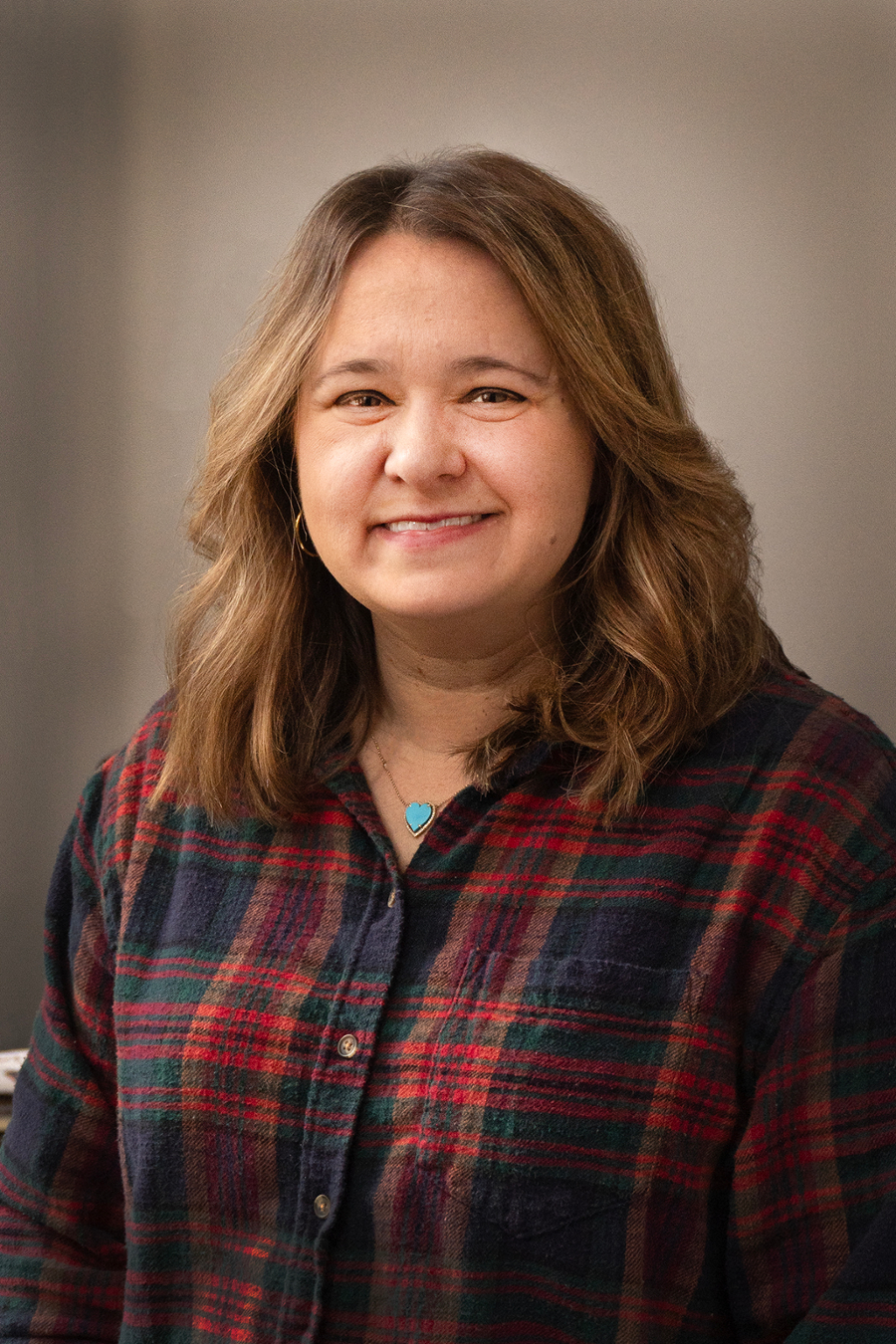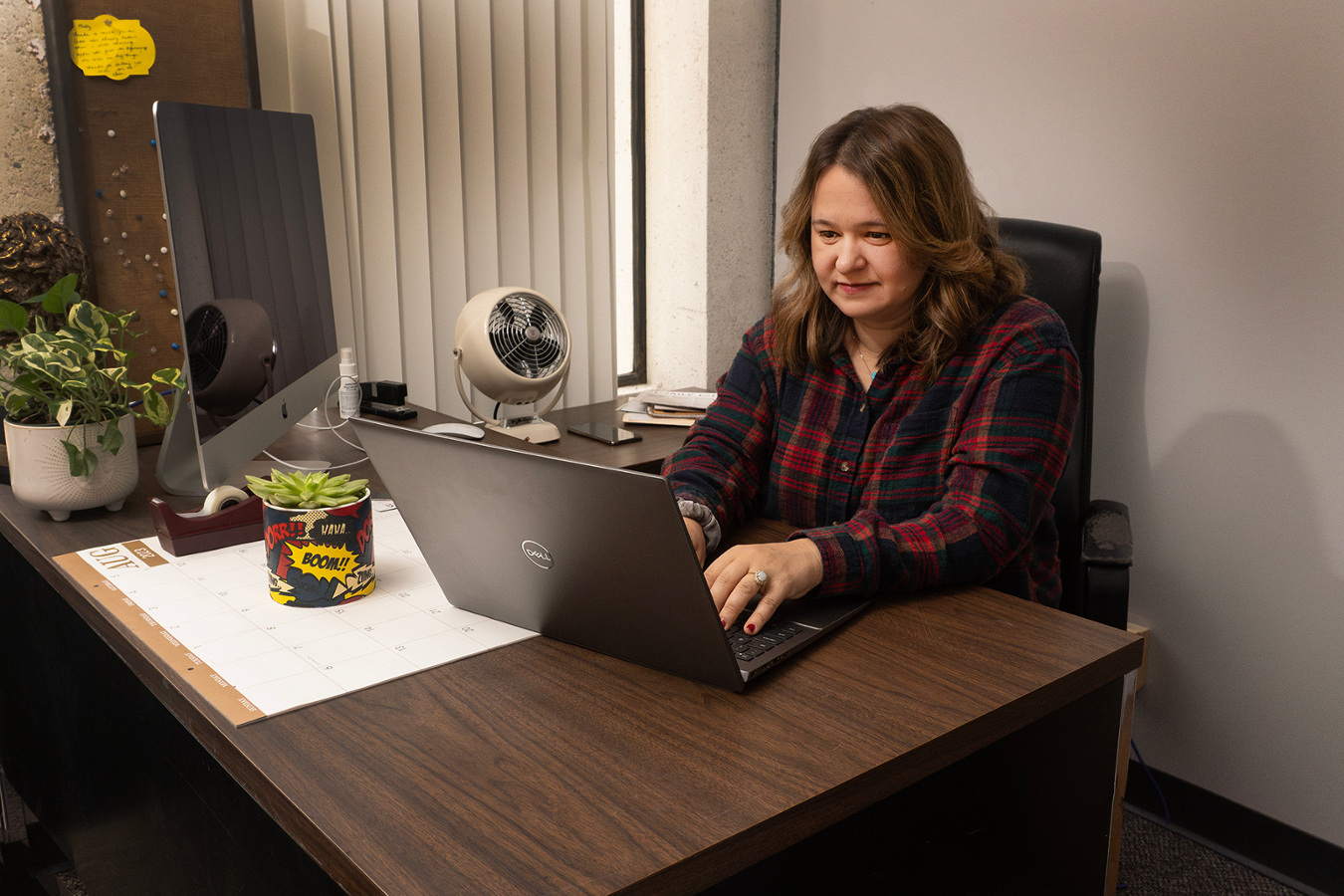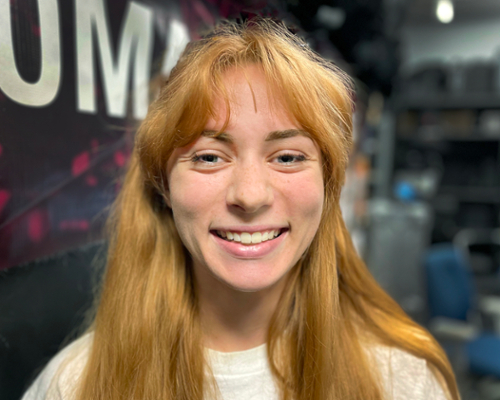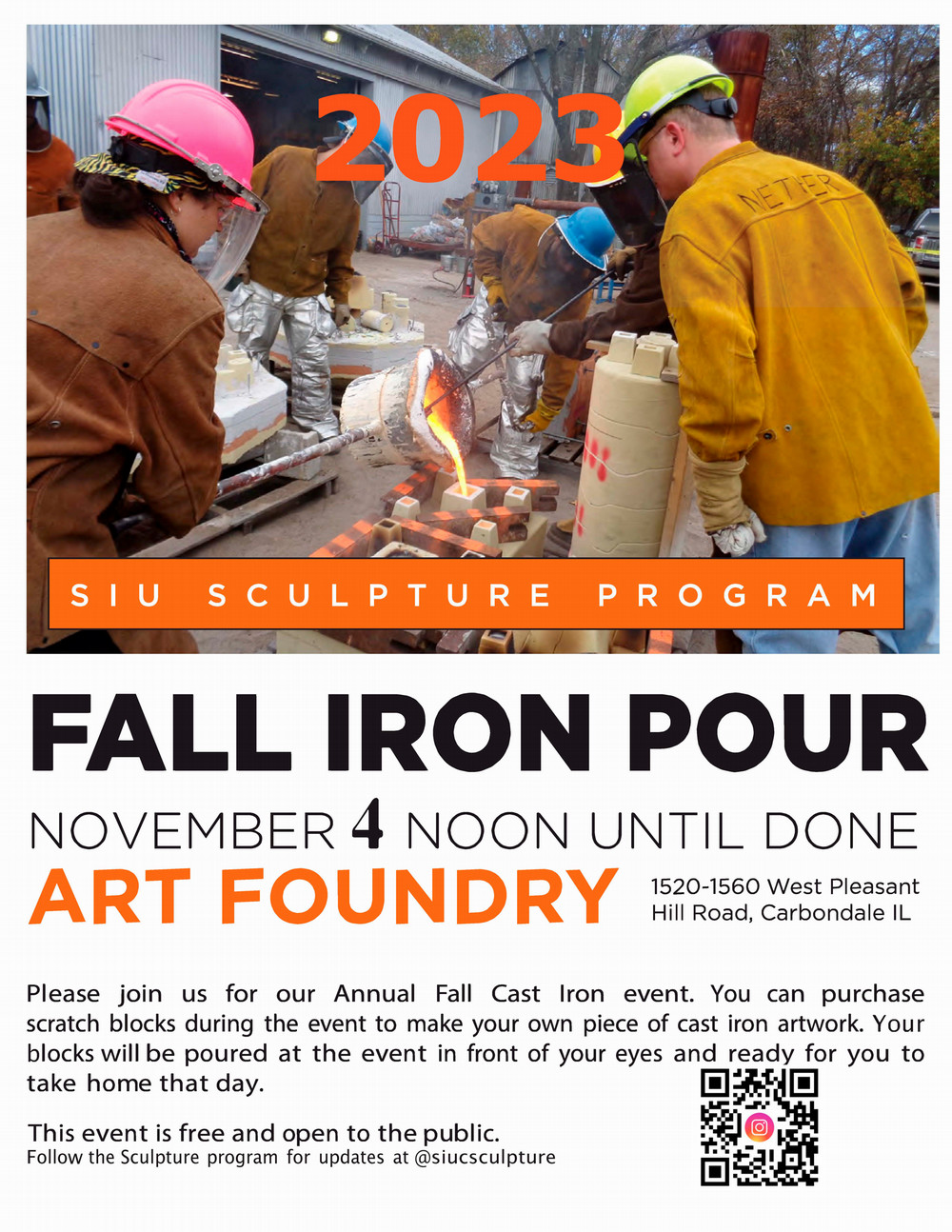CAMtastic Newsletter December 2023
Student Artists Create Molten Masterpieces at Annual Iron Pour
Two students dressed head to toe in leather and metal each hold one end of a long pole with a large ladle full of molten iron in the middle. They carefully pour the 3000-degree iron into waiting molds, creating art pieces for waiting students, faculty and staff. Then it’s back to the furnace, or copula, to start the process over again.
This year’s annual fall Iron Pour was held Saturday, Nov. 4, coinciding with the School of Art and Design’s Fall Arts Festival. Other areas from the school, such as printmaking, blacksmithing, and ceramics, were also on hand to do live demos and showcase artwork.
The iron pour generally results in 30-70 pieces of student art.
“We generally pour between 1500 to 2800 hundred pounds, with some molds holding up to 250 pounds of hot metal,” said organizer Alex Lopex, an associate professor of sculpture in the School of Art and Design.
He said the type of art created is “vast and varied.”
“From body parts, animals, boxing gloves, bugs, hybrid creatures, organic and inorganic shapes, forms and textures, and tools,” Lopez said.
The oddest design he’s seen?
“A wedding and prom dress, although it is not that odd as it is challenging to make happen. Lots of science is involved to make it work right,” he said.
While the annual spring iron pour is a closed event, the fall pour is open to the public.
“We sell scratch blocks in various shapes made of sand molds. The public renders their designs onto the tiles, and we cast them on site while they watch,” Lopez said. “We generally sell anywhere from 60-120 tiles. We get a lot of interested folks wanting to participate, and this is their way of being a part of the fun. For the last two years, the Art Education students have volunteered to educate and assist campus and high school students, young children, and parents with their designs.”
Safety is a top concern, with observers kept well back from the furnace and pouring areas.
“Everyone is suited up with leather or metalized safety gear from head to toe. In the casting world, they are known just as leathers. We also conduct dry runs on how things will happen and prepare for possible issues,” Lopez said. “A safety discussion happens before and on the day of the event. Everyone is assigned a task on the field, and students with little to no experience are teamed up with experienced students and faculty.”
Lopez said the pours help students prepare for various aspects of their careers.
“There are many facets to career direction, from going onward to graduate school, working in the foundry industry, to being technicians for art programs, teaching, and practicing artists in their respective fields of the dimensional arts,” he said. “Keep in mind this is just one technical approach to art production the sculpture program offers. We also offer woodworking, digital, and metal fabrication courses, adding more approaches and technical advantages students can retain to develop their skills and talent further.”
Iron casting dates back to anywhere between the 3rd to 6th century BCE in China. It was initially used to make farming implements and pots, in addition to weapons and pagodas. The first ironworks in the U.S. was built near what’s now Richmond, Virginia, in 1619.
“Look for the Broken Parts:” Tenure-Track Assistant Professor Molly Parker Talks About Her Award-Winning Approach to Investigative Journalism 
Acclaimed investigative reporter Molly Parker, who officially joined the School of Journalism and Advertising as an assistant professor this year, says she hopes to inspire her students to shine a light in the dark corners of the world. “I hope that everyone leaves the classroom with an appreciation of news,” she said. “And I hope that most of them are bit by the journalism bug and realize the exciting career it can offer for a lifetime.”
Parker, 41, is teaching a class in investigative techniques.
“I really try to encourage my students to keep digging, asking questions and reporting, well after they think they’re done,” she said.
Those students are learning from one of the region’s best. Parker was recently honored with multiple awards for a monthslong series investigating “abuse, neglect and cover-ups at a state-run developmental center in southern Illinois and other similar facilities across the state.”
“We spent more than a year looking into issues at Choate Mental Health and Developmental Center and published more than a dozen stories as a result of our reporting,” she said.
In one case, Parker and her reporting partner, Beth Hundsdorfer, identified workers who remained on paid leave seven years after they were accused of helping cover up a severe beating of a Choate resident by a colleague. In another, they obtained a recording of a 911 call that was accidentally placed during a patient restraint. Though a worker was overheard on the call threatening to break the patient’s finger, no one was arrested. The workers who were involved remained on paid leave more than a year later.
The series won the Robert F. Kennedy Domestic Print Award, given by the Robert F. Kennedy Center for Justice and Human Rights. It also garnered a first-place prize given by the National Center on Disability and Journalism.
“Citing our ongoing coverage, Gov. J.B. Pritzker and other senior state officials announced a plan in March to move about half of the residents out of Choate,” Parker said. “The Illinois Department of Human Services, which operates Choate, also announced widespread safety reforms, including the installation of cameras there and inside its other six developmental centers located throughout the state.”
A select group of students will soon be able to work alongside Parker in future investigations. Parker and assistant professor Julia Rendleman just “collectively secured just shy of $30,000 in funding to hire students as fellows over several years to cover important regional topics alongside us,” Parker said.
The funding comes from the Illinois Press Foundation, the Robert R. McCormick Foundation and the Pulitzer Center on Crisis Reporting.
“The students will work closely with Julia and I to publish work with Capitol News Illinois, the nonprofit news wire service of the Illinois Press Foundation that is distributed to more than 700 digital, print and broadcast outlets statewide,” Parker said. “The students may pitch and produce their own projects, or they may work collaboratively with us – or ideally both – over the course of a semester or academic year.”
Parker said she enjoys working with students.
“They are smart and creative and have great ideas. Several of the students in my investigative reporting class this fall have pitched deep dives on underreported topics of great importance to students of color and students with disabilities. I appreciate their heart and drive to make a difference in their worlds. It’s fun to be part of shaping their interest in journalism,” she said.
She’s happy to see the School of Journalism and Advertising work toward more “real world learning experiences.”
“What I enjoy most is turning the classroom into a real newsroom of sorts, with editorial meetings, weekly check-ins and, hopefully, stories that can be produced with the Daily Egyptian, WSIU or other media outlets,” she said.
 Parker’s approach to investigations is simple. Start with research. Lots of research.
Parker’s approach to investigations is simple. Start with research. Lots of research. “I read everything I can find that’s been written on the topic I want to write about. And I interview as many experts as I can find. I try to find people with varying opinions on how to approach the issue I’m writing about so I’m well grounded in the nuances of the topic,” she said.
Parker talks to her students about making their stories reflect those who are most impacted.
“Any good investigative story has a compelling narrative, which is best told with “real” people, those directly affected by the issue, rather than experts,” she said. “We spend a lot of time trying to identify people who can share their stories.”
As for story ideas, Parker said “I try to pay attention to the world around me and look for the broken parts that are in need of attention.”
Her stories focus on the southern Illinois region because she makes her home in Murphysboro, with her husband and 2-year-old twin boys.
Parker writes for Capitol News Illinois, the nonprofit arm of the Illinois Press Foundation whose stories about state government are distributed to more than 800 newspaper and broadcast media outlets. She is also a ProPublica Distinguished Fellow in its Local Reporting Network.
When she is not teaching or reporting, she enjoys reading cooking, running and hanging out with friends and family.
“We also enjoy getting out with our kids and seeing everything anew through their eyes,” she said. “We love Saluki basketball…well, really all things Salukis.”
Coping with Finals at CAM 
With finals around the corner and everyone getting into a study groove, I thought it might be interesting to see what some finals in the College of Arts and Media might be like, with schools like Theater and Dance, Media Arts, Music, Architecture, Journalism, and Art and Design. It's a different learning environment; it's hard to test what you're learning in such a hands-on field with a fill-in-the-bubble archetype.
Many of these students will be working on final projects leading up to finals week. I know I will be working on producing, filming, and editing a few video projects as well as a final photography portfolio and web design using coding we have been learning throughout the semester.
Hayley Hutchins, 3rd year MFA student in costume design describes her experience with finals.
“We don't necessarily have tests but we have a lot of final projects. So I spent the last three weeks or so focusing on pushing through, I don't really make any other plans,” she said.
She is bringing up the differences in how we spend our time compared to some other majors leading up to finals. Instead of studying for a test like some other majors, often we spend the time creating and thinking back to what we have been working on throughout the semester in all of our classes and finding ways to incorporate it into our work.
When going through these final weeks of projects, it's important to keep in mind working on your projects over time will help you get a more objective view to be able to take step back and to really put your all into whatever you are working on, whether it be a painting, a final article, an advertising presentation, a building model or a composed piece of music.
Lizzy Newman, an Art history major also noted some of the ways she likes to prepare.
“I like working with other people because you can say your thoughts and then you can figure out if it makes sense or not, based on the other person's reaction,” she said.
Getting a perspective from another student, your professor or a teaching assistant is also a phenomenal way to get input on how things are going and give you a better understanding of your work.
Although CAM is chalked full of creativity and project-based learning, there are still many classes based more in theory, strategy and execution that require a written or multiple-choice test, so working on the balance of studying for a written, oral, or multiple-choice exam while also finishing on your final projects can be a daunting task.
Kylah Smith senior in fashion design said, “I think my biggest piece of advice would just be to breathe and relax. I know a lot of people can get stressed out about finals. But you know, just kind of take your time and stay organized. And as long as you stay organized, and you're on top of things, then there’s nothing to worry about.”
Whether you are taking an exam in a more traditional sense or working on creating a final project or a combination of the two, take time to remember why you're here, why you chose this major and how best to fit this information into your life to better your work and your career. Your finals should be easy if it's something you enjoy, do it to the best of your ability and everything will flow smoothly.
Most importantly good luck!
